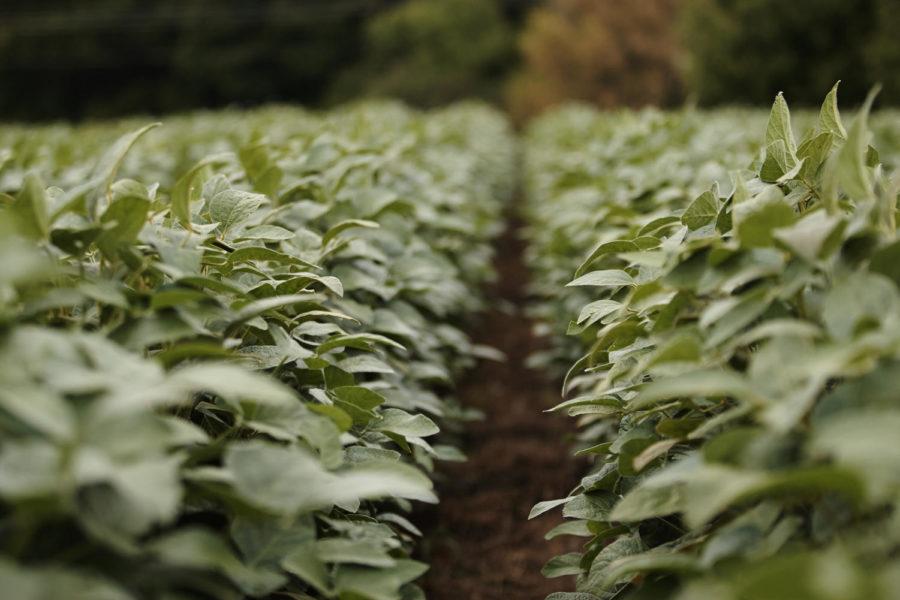- App Content
- App Content / News
- News
- News / Politics And Administration
- News / Politics And Administration / State
Next two weeks “critical” to Iowa farmers with development of tariffs and soybean prices, says Iowa State economics professor
Soybeans near maturity in a soybean field south of the Cap Timm Field.
June 20, 2018
The next two weeks are critical for the future of tariffs between China and the United States, according to an Iowa State agricultural economics professor.
Talks about tariffs, which could hurt Iowa farmers, between the United States and China have grown recently as President Donald Trump has began making what he sees as favorable trade a priority of his administration.
“All of this tariff talk really started at the first of the year,” said Chad Hart, associate professor of economics for the College of Agriculture and Life Sciences at Iowa State.
A tariff is a tax on foreign goods sold in the United States. For example, a 25 percent tariff on a $10 good would be $2.50. This can influence people to buy domestic goods rather than goods from a foreign country a tariff has been placed on.
“There are really two trade issues that involve the U.S. and China,” Hart said.
The first issue, Hart said, involves China’s handling of intellectual property rights of U.S. goods.
“Every president since [Richard] Nixon and [Gerald] Ford have had an issue with intellectual property and China,” Hart said. “Let’s say you want to sell a product in China, the way the laws are written now for the most part require you to take on a chinese partner. You would have to share your technology information with them, and then they could start their own company if they wanted to.
“That just isn’t the way we play here. In the U.S. you own the intellectual property of your technology, and you have certain rights over that technology for a time before other people can develop it.”
Hart said the other issue Trump is addressing with tariffs includes the trade deficits.
According to Hart, there is about $130-140 billion worth of goods shipped to China from the United States, while the United States receives over $500 billion in Chinese goods.
However, this trade deficit isn’t necessarily a bad thing, according to Hart.
“When you break it down, it really isn’t good or bad,” Hart said. “The U.S. mainly exports life sustaining goods like ag, energy and transportation. The U.S. markets are more consumer driven, so China exports a lot of our fashion, furniture and manufacturing goods.”
Despite the monetary trade deficit in those areas, Hart says the United States runs a surplus in other ways. For instance, the United States receives a large amount of money from China when they buy debt, and the United States gets a lot of “the best and the brightest minds” at universities and institutions.
Concerns over intellectual property and trade deficits have led the United States to put tariffs on over 1,300 Chinese goods amounting to over $50 billion. The Chinese, in return, have started putting tariffs on 128 U.S. goods, namely soybeans. This back and forth implementation of trade barriers is what is known as a trade war and something Trump has said “is easy to win.”
Hart thinks Trump’s rhetoric in this case is centered on a long-term solution.
“When you look at the short term, there is no real winner in a trade war,” Hart said. “It is more about minimizing your loses. What I think he means, is that if you want to win a trade war or trade disputes, it is best to move to fairer, freer trade.”
While moving towards his goals, Hart says, Trump’s tough talk and implementation of tariffs has already impacted Iowa farmers.
“The price of soybeans has fallen by about $1.50 since the talk on tariffs started,” Hart said.
This drop in soybean prices is largely due to the anticipation of future tariffs rather than current ones.
“When you look at what has been talked about and what has been done, you see that a whole lot hasn’t actually been done,” Hart said. “Right now, we are in the negotiation phase for most of these tariffs, meaning a large majority of the tariffs are just talk at this point.”
Hart said the deadline for these negotiations is July 6, 2018, but even if the negotiations go well, it is “almost certain” more tariffs will come.
“It will be interesting to look at over the next 2-to-3 weeks,” Hart said. “Those negotiations will be critical when it comes to soybeans.”
Soybeans are a large part of the Iowa economy, Hart explained.
“By area, they are the number one largest crop in the U.S., and China is the number one consumer of soybeans,” Hart said.
While the tariffs that were implemented will lower the consumption of U.S. grown soybeans overseas, it won’t eliminate it.
“China gets their soybeans from many other countries like Brazil, but the sheer amount of soybeans produced in the U.S. means China will still have to get some from the U.S.,” Hart said.
Outside of economic reasons, China may also have a political incentive to target U.S. exports of soybeans.
“$20 [billion] to $25 billion of U.S. exports to China are ag related,” Hart said. “For China to have the largest political impact with their tariffs, targeting the rural economies which typically lean conservatively, or who might have voted for Trump, is their best option.”
Hart said this pressure could push back on Trump enough for him to back down, but no matter the outcome of the negotiations, the impact on crop prices is likely to move into harvest season when most farmers sell their crops.







